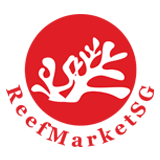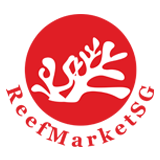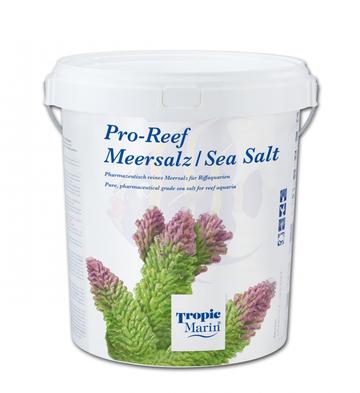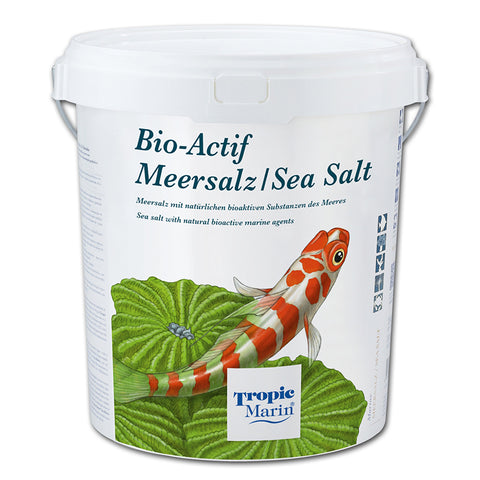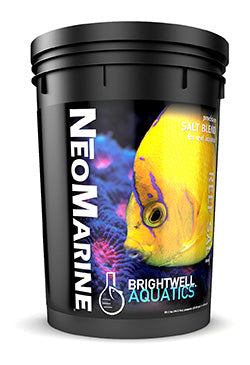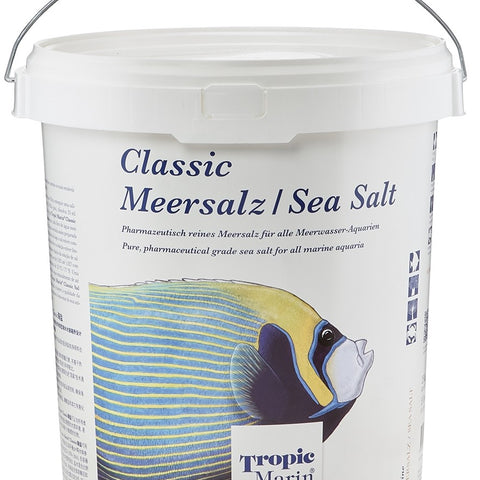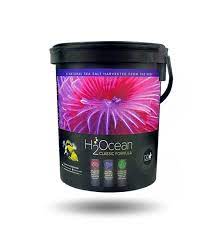Sidebar
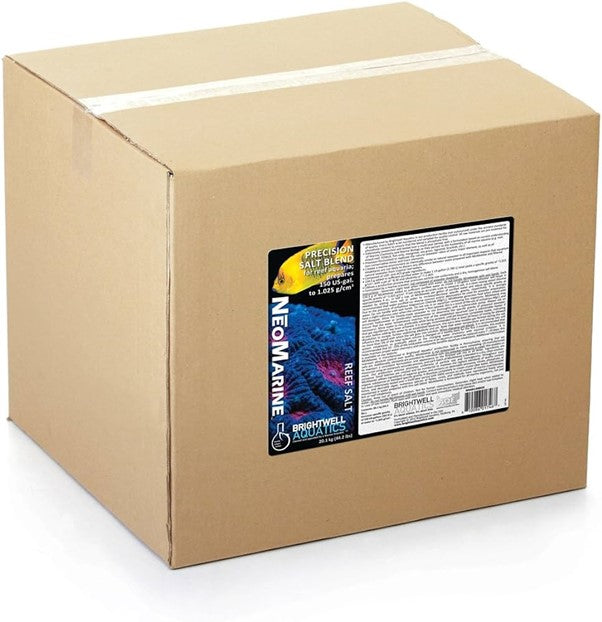
BRIGHTWELL AQUATICS NeoMarine 20.1KG Box
Regular price $135.00
In Stock
- FREE Store Pick Up
RBRI-00243
Category:
Overview
- Extensively-researched and tested over a multi-year period, with a formulation based on current understanding of Marine Chemistry and Marine Biology as they pertain to the husbandry of all marine aquaria (e.g. reef, mixed reef, FOWLR, fish-only, mangrove, sea grass, lagoonal, brackish, etc.)
- Precision-formulated to replicate the natural seawater ratios of every major element, as well as all non-conservative minor and trace elements.
- Creates a marine environment so chemically-similar to natural seawater in all important respects that aquarium inhabitants are not likely to discern any difference between water prepared with NēoMarine and filtered natural seawater from tropical reef waters.
- Contains USP, ACS Reagent-grade, FCC Food grade and chemically assayed ingredients.
- 134 g per 1 US-gallon (3.785 L) of purified water yields a specific gravity of ~1.025 g/cm3, with a pH of ~8.30 and alkalinity of ~7.5 dKH.
- Manufactured by Brightwell Aquatics in our production facility (not outsourced) under the strictest standards of quality. Every batch is lot numbered and sampled for quality control.
- Utilizes a production process that promotes particle size uniformity and a dry, homogenous salt blend.
- Formulated by a marine scientist; not composed of seawater evaporite.
Technical Overview
Marine chemists estimate that the chemical composition of seawater has remained relatively constant over the past several hundred-million years (perhaps longer than the last billion years); this stability is largely a result of the immense volume of the ocean and the physical, chemical, geological, and biological processes taking place within it. The so-called “modern day” corals largely responsible for building reefs in tropical marine environments have been in existence for well over 200-million years (soft corals have been around much longer than that!), and more primitive life forms (such as sponges) have been around still longer, collectively evolving and thriving in relatively stable chemical conditions. Recent findings by advanced aquarists and scientists in many countries confirm what has long been suspected: there is no obvious benefit to maintaining the concentrations of calcium and other elements depleted by reef-building organisms at grossly elevated levels; in fact, this practice can be detrimental to their long-term survival. All of these points taken into consideration, it seems elementary to replicate the most important aspects of natural chemical composition of seawater as closely as possible to properly care for delicate marine creatures in captivity. The single most important contributor to success with a marine aquarium is maintaining water parameters within tolerable ranges; no amount of lighting and filtration can compensate for water that is lacking in numerous essential elements and that does not meet the criteria required for survival by marine organisms. A successful marine aquarium therefore begins with quality seawater.
Brightwell Aquatics NēoMarine Salt Mix creates an ideal marine environment for aquarium inhabitants by providing all major elements, all non-conservative (depleted by natural chemical and biological processes) minor and trace elements, and elements known to be utilized in the production of biological pigments (biochromes) in precise natural seawater ratios; all ions are formulated to be present in natural seawater concentrations. Conservative minor and trace elements are not depleted in marine environments, indicating that they are not utilized by marine life or do not take part in chemical reactions in seawater; as such, they are not necessary for the survival of aquarium inhabitants, and are not part of the NēoMarine formulation. NēoMarine is not formulated to have enhanced concentrations of certain elements at the expense of sacrificing others and creating a solution with grossly inaccurate elemental ratios; this formulation is based wholly on current marine science data and extensive testing.
NēoMarine is manufactured in Brightwell Aquatics’ production facility in Alabama, ensuring that we maintain absolute control over quality; NēoMarine is not outsourced as many competing US-manufactured salts are. Additionally, elements are provided by individual salts (no seawater evaporite is used); this enables us to maintain a consistent formulation and appearance to the finished salt mix at all times. Ingredients are measured using an extremely accurate process, and each batch of NēoMarine is blended in a dry, clean environment. Our production process promotes uniformity of particle size and homogeneity throughout each container. Small batches are created and lot numbered to maintain the highest standards of quality control. NēoMarine utilizes ingredients of superior grades, and contains no detectable ammonia, nitrate, phosphate, or organic substances at standard specific gravity. It dissolves completely to create crystal clear water. NēoMarine has been extensively tested over a multi-year period with 100% success on all manner of marine invertebrates, fishes, and desirable algae; numerous species of fishes, corals, and mollusks have reproduced freely when maintained in water prepared with this salt blend. NēoMarine is formulated for all marine organisms, not just fish or reef inhabitants.
Instructions & Guidelines
Do not mix in an aquarium containing live organisms. NēoMarine creates slight heat when mixed into water; therefore, do not handle dry NēoMarine with wet hands. NēoMarine may have a slight sulfurous odor when the container is first opened; this is a result of the use of anhydrous magnesium chloride and sulfate and will dissipate. Each 134.5 g of NēoMarine added to sufficient purified water to create 1 US-gallon total saltwater will result in specific gravity of ~1.025 g/cm3. If not using an accurate scale to measure salt, in a clean mixing vessel dissolve approximately 4 oz., or half a cup, of NēoMarine per gallon of purified water and adjust specific gravity as needed by adding more salt or water to increase/decrease specific gravity, respectively. It is strongly recommended that water purified via reverse osmosis and/or deionization be used for seawater preparation. Place the full amount of water you intend to mix into a mixing vessel. Heat the water to 76 to 78 deg F first before adding NēoMarine mix. Add NēoMarine slowly, mixing vigorously all the while! Allow the freshly-made seawater to mix thoroughly with a submersible pump for not less than one hour. Always use an accurate hydrometer or (preferably) refractometer to determine the specific gravity of prepared seawater. Ensure that the water temperature matches that of the established aquarium. Allow water to mix, preferably while being aerated, until pH becomes completely stable, indicating that gas equilibrium has been achieved. Although water can be used in an hour, It is strongly recommended that at least 24-hours of mixing be allowed to pass before adding the water to an established aquarium; this extra time enables gas formed during the salt dissolution to escape, further stabilizing alkalinity and pH. Note that water temperature and mixing rate will influence the speed with which the salt goes into solution. It is recommended that 10 - 20% of the total water volume in an aquarium system be replaced every 7 - 10 days; this helps maintain proper water chemistry and consequently benefits aquarium inhabitants.
Causes of Cloudiness: NēoMarine is an anhydrous salt, meaning that is is much drier than most salts (which are hydrated meaning they contain water, quite a bit of it). If you add NēoMarine to water too fast, it will cloud.
- Water too cold. Always heat the water to 76 to 78 deg F before you begin.
- Adding too much salt or adding it too fast, or just dumping it in and allowing it to lay on the bottom of the container without stirring and agitation. Cloudiness will form under these conditions.
- Not using the full volume of water. Always use the full amount of water and gradually bring up the salinity in the mixing container, adding the salt over a period of time. If you don't you will get cloudiness.
- What to do if you have mixed it wrong and it is cloudy: Cloudiness is not dangerous, it is just the formation of carbonates of divalent cations, such as calcium, into tiny particles. When added to the aquarium, it will dissolve over several days. Adding it through a fine filter sock may remove some of the particles and allow them to dissolve unseen, over time.
Caution: Keep out of reach of children. Not for human consumption. Generates slight heat when added to water; do not handle NēoMarine with wet hands. Contact with dry product may cause skin and/or eye irritation. In case of eye contact, flush eyes with cool water and seek immediate medical attention.
Water changes in all marine aquaria should be made weekly to help maintain the natural seawater ionic ratios. The addition of supplements (which add elements that are affected by both biological and chemical interactions (non-conservative elements), as well as others that are not affected by these processes (conservative elements) and therefore accumulate with time unless removed with water changes), the depletion of various non-conservative elements, loss of salt to the external environment through water spraying, interaction of various elements with organic matter in the aquarium, and removal of elements via chemical filtration all alter the ionic ratio of the water. Weekly water changes of at least 5% of the total volume of water in the system will help counter these processes and provide a more stable environment for ornamental marine organisms. Note that if an aquarium is established with an inexpensive synthetic salt blend lacking adequate concentrations of non-conservative elements, additional money must be spent on supplements to correct the deficiencies before any animals are introduced to the system; these supplements may contain conservative elements that further alter the ionic ratio of the water. In light of these facts, it can be said that purchasing an inexpensive salt blend saves no money in the long run and does not encourage the health of livestock.
Switching from your present salt mix to NēoMarine: Stability of water chemistry is one of the most important aspects of successfully maintaining a marine aquarium. Therefore, sudden changes in water chemistry, such as when making high-volume water changes with water that has different chemical characteristics (no matter how slight the differences are), can have significant negative impacts on the livestock; even if they appear to be healthy initially, they may very well be found in poor appearance or even deceased a few hours later. This is often the case when manufacturers alter their salt formulation (either by accident or design) without informing their customers; what would seem to be a routine water change with a salt that has been used for months or even years can result in disaster.
It is imperative when changing from your current brand or formula of salt to a new one that the transition be gradual. We strongly recommend that the maximum water changed when switching to a new salt mix not exceed 5% of the total system volume (taking the water in sumps and displacement of water due to rock and bottom substrate into account) per 7-day period. This maintains relative stability in the water chemistry and has a much lower impact on aquarium inhabitants than does changing larger volumes. While it may take 5 – 6 months to completely switch over to a new formula (when doing a weekly 5% water change; water changes with less frequency will increase the time to complete transition accordingly), this should not be viewed as a nuisance, but rather as insurance that the livestock will make the transition smoothly and without illness or death. Considering the degree of care that goes into maintaining most marine aquaria, this method of careful transition is well worth the effort.
As you may have read on the outside of the NēoMarine container, we make the claim that it is so close in composition to natural seawater that marine organisms cannot tell the difference. How can we make this claim if the product does not provide every element present in natural seawater?
The answers are not as complicated as one might think, and may be addressed in three separate but very important aspects: 1.) the nature of the elements present; 2.) their concentrations with respect to average natural seawater parameters; 3.) the quality of ingredients utilized and the means in which the salt is produced. These points are addressed individually below.
First, all major elements are present in NēoMarine, however only minor and trace elements known to undergo biological and/or chemical interactions (e.g. depletion) in natural seawater are included. What this means is that there is a specific change (decrease) in the concentration profile of the element measured in the surface waters where life is concentrated; such elements are believed to interact with marine life and/or with other substances present in the water, and these elements are considered to exhibit “non-conservative” behavior. Elements that do not exhibit these characteristics do not apparently interact with marine life or these other substances (at least as far as current analytical methods can discern); they are not likely necessary for the continued health or existence of marine organisms. It follows that these elements are not required for success with a marine aquarium; in fact, if added they would gradually accumulate with time. Because of this, they may be omitted from the salt mix and the savings in raw materials and production procedures passed on to the aquarist.
Second, the comparison table on the outside of the package indicates that, when mixed to a specific gravity of 1.025 g/cm3, the concentrations of elements present are extraordinarily close to those observed in natural seawater; in fact, with only one exception (chloride), all major, minor, and trace elements present are in the proportions to one another that they are in natural seawater. The natural seawater concentrations of elements listed are taken from current data compiled by oceanographers, and the formula is adjusted as analytical methods are improved and new data becomes available. These changes are so minute that they will not noticeably alter the performance of the salt or the appearance of aquarium inhabitants; we simply want the concentrations of elements present to remain as close to those found in natural seawater as possible.
Third, as with all Brightwell Aquatics water care products, we use the very highest purity ingredients available, period. This means that the majority of individual ingredients in NēoMarine are of USP, ACS Reagent or FCC Food grade or purchased by chemical assay, the highest levels of purity in existence. We do not cut any corners when it comes to what goes into our products. Additionally, we manufacture our salt mix on-site under very strict environmental conditions, ensuring the maximum degree of quality and accuracy to our formulation, and every container of NēoMarine is lot numbered for quality control.
This formula has undergone extensive testing and has produced very impressive results. Livestock from every common family of ornamental marine organisms has been maintained in water prepared with this formula without incident, many of them reproducing freely when they had not done so in aquaria maintained with other salt brands.
If you have purchased a package, used a portion of it, and find that the salt falls short of your expectations, please do not hesitate to contact us. We want you to use this salt and be 100% satisfied with it. We are confident that NēoMarine Salt Mix is the best such product on the market because we have formulated it to contain everything needed by marine life in precise natural seawater concentrations, and because we have paid such close attention to all pertinent details of purity and manufacturing.
A Brief Discussion of Specific Gravity (Density) and Salinity
Specific gravity is a measurement of density, and the relationship that it has with salinity is dependant upon water temperature. Oceanographers generally agree that the average salinity of the world’s oceans is ~35.0‰, however the salinity of water in some areas may be considerably higher. This is largely a result of the balance between evaporation and influx of freshwater in specific areas and/or bodies of water; the higher the rate of evaporation and/or the lower the relative volume of freshwater influx, the higher the average salinity tends to be. The Red Sea is a prime example of this: essentially surrounded by desert and with very little exchange of water between itself and neighboring water bodies, the average salinity tends to be quite high relative to that of other tropical marine environments; areas of the Red Sea may exceed 40‰ at times. For the most part, however, salinity in tropical areas tends to fall between 35 – 37‰, and this is a sensible range to maintain within marine aquaria.
Additional Information
What’s in NēoMarine:
- Water too cold. Always heat the water to 76 to 78 deg F before you begin.
- Adding too much salt or adding it too fast, or just dumping it in and allowing it to lay on the bottom of the container without stirring and agitation. Cloudiness will form under these conditions.
- Not using the full volume of water. Always use the full amount of water and gradually bring up the salinity in the mixing container, adding the salt over a period of time. If you don't you will get cloudiness.
- What to do if you have mixed it wrong and it is cloudy: Cloudiness is not dangerous, it is just the formation of carbonates of divalent cations, such as calcium, into tiny particles. When added to the aquarium, it will dissolve over several days. Adding it through a fine filter sock may remove some of the particles and allow them to dissolve unseen, over time.
What’s not in NēoMarine:
- Anti-caking agents
- Vitamins, amino acids, and other unnecessary organic substances
- Hydrated forms of major elements such as magnesium and calcium
- Saltwater evaporite (e.g. dehydrated saltwater, a waste product from conversion of seawater for human drinking. One of the main problems of this kind of salt is that it lies on the desert for months or years open to the atmosphere. It is not uncommon to have a high sand content, as well as bird or reptile droppings in it.)
- Ammonia*
- Phosphate*
*Ammonia and phosphate are undetectable in water prepared to 1.025 g/cm3 using Hach standard test kits with reagents within the usable dates. Every batch is tested and results are logged.
How was NēoMarine formulated?
Basically, we reverse-engineered saltwater by creating an extremely-precise calculation method that takes into account all necessary chemical characteristics of the salts that provide desirable elements. Natural seawater concentrations of all major elements, as well as the minor and trace elements that are considered to be non-conservative (e.g. they are utilized in biological and chemical processes that occur in marine environments), were used as the design template. We then tested several combinations of ingredients that ultimately provided identical concentrations of each important element; we were specifically interested in assessing the dryness and homogeneity of the blend, as well as the solubility and speed with which the blend completely dissolved into solution. For what it’s worth, the final formulation provides all major, minor, and trace elements at concentrations at their respective average natural seawater concentrations. We strive to reproduce this formulation with our production process.
How was NēoMarine tested?
Once we had arrived at a final formulation, we tested it in multiple research systems for a period of three years. Our research systems house all conceivable types of marine fishes, cnidarians, bivalves, gastropods, echinoderms, crustaceans, coelenterates, and poriferans, as well as ancillary organisms such as suspension-feeding worms, macroalgae, sea grasses, and mangroves. We have exclusively been using our salt formulation on every system during the three-year testing process, with remarkable success: several coral spawning events have taken place, fishes have reproduced, and the coloration and apparent health of all residents in the systems is very good. Additionally, NeoMarine has been successfully used in a large reef aquarium on display at a prominent national museum in the Nation’s Capitol.
How is NēoMarine manufactured?
We’ll give you a hint: no cement mixers are used! The exact process is deemed proprietary, but what we can divulge is that the process is such that a homogenous particle size and blend are created in a clean, climate-controlled atmosphere within our own production facility. Rather than producing several tons of NēoMarine in each batch, we create batches of modest-size that enable us to maintain maximum quality control and ensure the most homogenous blend; the more ingredients that are used, the more difficult it is to create homogeneity throughout the finished product (our formulation makes use of nearly 40 ingredients, for reference), so producing gigantic batches of salt is not an option for us. If we were just blending table salt with “ice-melt” and calcium chloride flake and calling that a finished product, we could make multi-ton batches and not lose any sleep doing so.
How long does it take for NēoMarine to dissolve?
On average, 75°F water that has the proper amount of NēoMarine added to increase the specific gravity to 1.025 g/cm3 will clear in less than 15-minutes with vigorous mixing, however when mixing a large batch (e.g. ≥50-gallons) all at once it may take longer for the mix to completely clear. Two things factor into the speed that a salt mix will clear in water of a standardized temperature: the degree of mixing taking place within the mixing vessel, and the solubility of the various salts that are present in a mix. Regarding the former, it can be said that the speed of dissolution is directly related to the amount of water movement in the vessel; that is, faster water movement decreases the time required for the mix to completely dissolve and clarify, assuming that samples are prepared using the same salt blend. Companies selling sea salt blends have been hyping the speed with which their salt dissolves completely for so long that aquarists now use this as a bench-mark to judge the quality of a salt mix; ironically, salts that mix immediately into water are typified by low concentrations of magnesium, calcium, and/or the use of a large percentage of highly-soluble hydrated ingredients that drag unwanted substances into their final product (see the following section). Honestly, salt water should mix overnight in order to allow all intermediate gasses formed during the dissolution process to escape and pH and alkalinity to become stable. If the newly-mixed saltwater doesn’t become crystal-clear within 30-seconds, who cares?
Why is NēoMarine more expensive than many competing brands?
As with all items baring the Brightwell Aquatics name, we do not cut corners in any aspect of the salt formulation or preparatory process. The primary reason that the salt is higher-priced is that the ingredients are of such high purity that they command a higher price from our vendors; for instance, because we use superior grades of anhydrous magnesium salts rather than low-grade hydrated forms (which contribute ammonia and considerable insoluble particulate material into a finished product), our cost increases by an order of magnitude. However, we wouldn’t use hydrated magnesium (or calcium) salts for the afore-mentioned reason, not to mention the additional weight that these salts add to a finished product (which factors into the final price that is paid at a retail-level as a result of the resultantly higher freight charges). Simply stated, NēoMarine is more expensive because it truly is made of better ingredients, and more of them. Furthermore, rather than prepare water to only 1.018 - 1.021 g/cm3, each container of NēoMarine prepares water to 1.025 g/cm3. In this aspect alone it costs us more to manufacture than it does our competitors whose salt blends fall short of this specific gravity. We run a chemical analysis for pH, alkalinity, calcium, ammonia, and phosphate on each batch of NēoMarine produced; this costs us money. Lastly, we manufacture NēoMarine and all other Brightwell Aquatics supplements and filtration media in-house using precision equipment that can be used for the production of foods and pharmaceuticals, we pay our personnel a good wage, and we are privately-owned so our operating expenses are expectedly-higher than those of many of our competitors.
In summary, we would like to make it known that we did not set out to create a salt blend that was superior to other salts in one aspect or another; that was never a consideration. Our intention was to make a salt blend that recreated all important aspects of natural seawater with such precision that captive marine organisms couldn’t noticeably tell the difference between water prepared with our salt and “the real thing”. To us, this approach merely makes the most sense, and we believe that your aquarium inhabitants will agree. Thank you for your interest in Brightwell Aquatics; we sincerely appreciate it. Oh – and remember: it’s more than an aquarium. It’s an obsession.
Free pick up at 108 Owen Road 218915 only

Related Products
- Choosing a selection results in a full page refresh.
Added to cart successfully. What's next?

Product type: 1
1 x $00.00
Order subtotal
$00.00
Continue shopping
The cookie settings on this website are set to 'allow all cookies' to give you the very best experience. Please click Accept Cookies to continue to use the site.
